Lumber Scrap Bins
Article - November 13, 2012
When it comes to lumber storage in the shop, we often see solutions for storing long boards and full-size sheetgoods. But one storage challenge that is easy to forget about is how to store our cut-offs, scraps and shorts. Every project takes long boards and turns them into shorter ones and the left-over material from these projects needs a place to call home. After all, if you’re anything like me, you probably hold on to scraps indefinitely. So whenever you are designing a lumber storage solution, keep in mind that you will also need to think about housing various smaller pieces that are of assorted widths and 4′ or less in length.
My plan for scrap storage is very simple and consists of nothing more than a few wall-mounted side-by-side bins. Since my plywood is now stored near the front door, the space under my lumber rack provides the perfect location for this much-needed storage solution.
Lumber Rack Detour
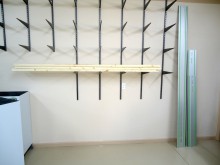 Speaking of the lumber rack, you’ll notice some significant changes from the previous version, primarily the fact that I am now using commercially-available metal racks. I opted for a metal system for several reasons. First, it takes up less space. I can fit more wood on each shelf simply because the brackets are very low-profile. Second reason is strength. While my wood lumber rack was certainly up to the task, metal racks can typically handle more weight. Third, this system is super easy to install. All I had to to was run the horizontal supports where the wall meets the ceiling and drop in the vertical standards in line with the wall studs. The brackets then drop into the standards and are easily adjustable to any height I need. And the final reason for the metal rack is because I already had a bunch of this stuff laying around from our old garage setup (not woodworking related). The big drawback of this system is that the components are not cheap. But I already had most of the parts on hand so I only had to spend a few more bucks to finish out the rack.
Speaking of the lumber rack, you’ll notice some significant changes from the previous version, primarily the fact that I am now using commercially-available metal racks. I opted for a metal system for several reasons. First, it takes up less space. I can fit more wood on each shelf simply because the brackets are very low-profile. Second reason is strength. While my wood lumber rack was certainly up to the task, metal racks can typically handle more weight. Third, this system is super easy to install. All I had to to was run the horizontal supports where the wall meets the ceiling and drop in the vertical standards in line with the wall studs. The brackets then drop into the standards and are easily adjustable to any height I need. And the final reason for the metal rack is because I already had a bunch of this stuff laying around from our old garage setup (not woodworking related). The big drawback of this system is that the components are not cheap. But I already had most of the parts on hand so I only had to spend a few more bucks to finish out the rack.
Waste Not, Want Not!
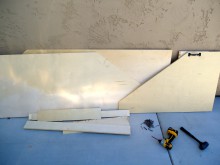 Now I know what some of you are thinking already: “This guy is so wasteful! He built that beautiful wood rack and plywood storage cart and now he’s building something new!?!” Well, fret not my friends! You’ll be glad to know that my old plywood roll-out cart was fully disassembled and cannibalized for several new shop projects, including these bins and my clamp racks. Nearly every part of these scrap bins will come from the old plywood cart, including the screws! Norm’s New Yankee frugality has nothin’ on me!
Now I know what some of you are thinking already: “This guy is so wasteful! He built that beautiful wood rack and plywood storage cart and now he’s building something new!?!” Well, fret not my friends! You’ll be glad to know that my old plywood roll-out cart was fully disassembled and cannibalized for several new shop projects, including these bins and my clamp racks. Nearly every part of these scrap bins will come from the old plywood cart, including the screws! Norm’s New Yankee frugality has nothin’ on me!
Construction
The dimensions of the bins really aren’t all that critical. Most times, you’ll simply conform to the space you have available. In my case I was also limited by the dimensions of the recycled materials I was using as a starting point. Each bin side was cut to size and notched at the bottom/back corner. The notch allows each piece to sit flush against the wall while leaving room for the baseboards. I also cut a short angle at the top/front corner of each piece for the sake of a nicer appearance and to reduce the hazards associated with sharp corners. I then attached several pieces of 2 x 3 construction lumber to the wall to act as supports. Each bin side was then screwed to the side of its respective 2 x 3. Can’t get much simpler than that!! You might notice that I made a late-game decision to remove the center 2×3, resulting in a larger center bin.
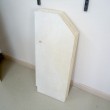
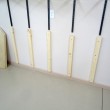
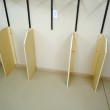
The final step is to attach a narrow foot board. Not only will this stabilize the sides, it will also help keep the scrap wood from sliding out of the bins. Using another scrap piece from my old plywood rack, I marked the location of each bin side with a pencil and used the tablesaw to cut dados in the appropriate locations. For a shop project like this, there’s nothing easier than taking measurements directly from the work itself. The fit was pretty much perfect. Relative dimensioning for the win!
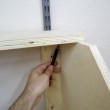
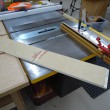
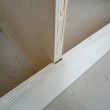
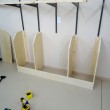
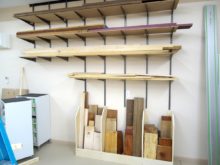 When it’s all said and done, using some scrap material and a single construction grade 2 x 3, I have all the scrap storage I could possibly need……for now anyway!
When it’s all said and done, using some scrap material and a single construction grade 2 x 3, I have all the scrap storage I could possibly need……for now anyway!
As always, if you have thoughts on how I might improve the design, feel free to let me know. It might be too late for me to make major changes but for the sake of others who might be searching for a scrap bin plan, it would be very helpful.
*Update* – The first few comments reminded me of one last detail I failed to include in the article. After the bins were assembled, I cut a few pieces of scrap 1/4″ plywood and dropped them into the bottom of each bin. This helps protect the concrete as well as the wood. Moisture isn’t much of an issue in Arizona but I still don’t want the wood resting directly on concrete.



